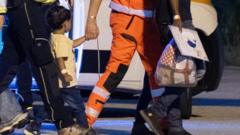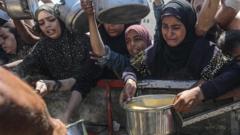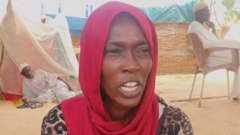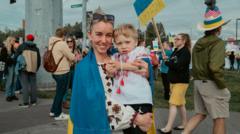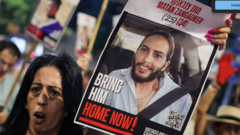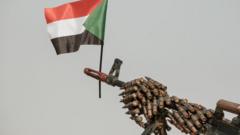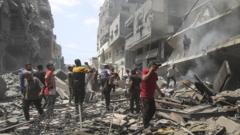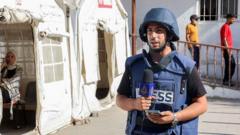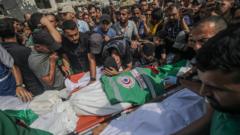As Israel intensifies its bombardment of Gaza City, creating dire humanitarian conditions, many residents are forced to flee while protests and general strikes arise in Israel against the government's occupation plans, echoing urgent calls for humanitarian action.
Displacement and Protests: Gaza City Faces Catastrophic Conditions Amid Israeli Attacks

Displacement and Protests: Gaza City Faces Catastrophic Conditions Amid Israeli Attacks
Thousands of Palestinians flee Gaza City as international protests erupt against Israeli occupation plans.
Amid ongoing Israeli airstrikes, thousands of residents have departed from the Zeitoun neighborhood in Gaza City, where continuous bombardment has escalated into a "catastrophic" humanitarian crisis, according to the local Hamas-run municipality. Reports indicate that at least 40 individuals lost their lives in the recent violence across the territory over the weekend. The Israeli military has announced plans to allow aid agencies to bring in tents to assist those displaced. This follows Israel's controversial plan to forcibly relocate a million residents from Gaza City to camps in the southern region.
In Israel, a one-day general strike is scheduled on Sunday as a protest against the government's decision to seize Gaza City, prompted by families of hostages and concerned citizens who fear that military expansion risks the lives of Israelis held captive by Hamas. This push for a general strike comes after a week of deliberations by Israel's war cabinet, which voted to occupy Gaza City, the largest urban center in the territory, a move that has drawn widespread condemnation, including from the UN Security Council.
The Israeli military body Cogat has communicated that they will resume the supply of tents and shelter materials to Gaza as part of their efforts to relocate civilians in combat zones for their safety. As the shelling continues, a spokesperson for the municipality reported mass displacements in Zeitoun, with the area, which houses around 50,000 people, experiencing acute shortages of food and water. Eyewitness Ghassan Kashko, 40, undergoing sheltering with his family in a local school, described the near-constant explosions associated with airstrikes and tank fire, lamenting the sleepless nights of fear and uncertainty.
Beyond the immediate threats of airstrikes, medical facilities have reported increasingly dire conditions, with less than 20% operational capacity at the remaining hospitals, primarily due to lack of medical supplies. The UN’s figures reveal that nearly 1.9 million people, constituting around 90% of Gaza’s population, are currently displaced. A report warned of rampant malnutrition across Gaza, with the dire situation leading to multiple deaths, including children, attributed to food scarcity.
In a tragic case highlighting the crisis's severity, a young Gazan woman evacuated to Italy for medical care succumbed to her ailments within two days of arrival, emphasizing the acute situation facing many. Global calls for urgent humanitarian assistance have arisen, with several international bodies highlighting the unfolding famine and urging immediate action to reverse starvation in Gaza.
The crisis followed Hamas's attack on Israel on October 7, which resulted in significant Israeli fatalities and hostages. In the subsequent Israeli offensive, the toll of Palestinian casualties has escalated dramatically, as casualties in Gaza exceed 61,000, as reported by organizations familiar with the local health ministry.
As the complexities of the Israel-Palestine conflict continue to unravel, the urgent need for humanitarian intervention grows ever more critical.

